
Anchor peg: The small peg at the end of the loom that is at a 90-degree angle to the loom. The beginning tail of the yarn is tied to this peg to hold it while the first several rows are being knit. After that, the beginning tail can be removed from the anchor peg.
Bind Off: Removing the knitting from the loom by finishing and securing each stitch in the row.
Cast On: The first wrap of the loom to put a single loop of yarn onto each peg.
Knit Off: Generally, a knit stitch is made by bringing the bottom loop on the peg up and over the top loop and 0off the peg toward the center of the loom. Sometimes, a knit stitch is made by bringing the bottom loop over two or more top loops, or by bringing two or more bottom loops over the top loop.
Peg pairs: Two parallel pegs equidistant from the anchor peg.
Remove Knitting From the Loom: Taking the knitting off the loom, leaving a row of live stitches that have a strand of scrap yarn running through them.
Scrap Yarn: A piece of yarn that is not part of the project itself, but is used to hold live stitches temporarily. It is best if the scrap yarn is a different color than the project color, smooth in texture and a larger diameter than the project yarn.

Tail: The cut end of yarn not part of the knitting. The beginning tail is the first 6 inches or so before the yarn is used to cast on or continue the knitting. The ending tail is the last 6 inches or so after the last stitch or bind off.
Wrap the Loom: To put the yarn on the pegs in a certain order until all pegs have a new loop on them. For some stitch patterns, all pegs are wrapped in one pass of the loom. For others, the yarn goes from top to bottom back to the top again before all pegs are wrapped.
Make a slip knot about 5 inches from the end of the yarn and put it on an anchor peg at one end of the loom.
Wrap the yarn around the outside of the pegs on the loom, first peg on the left, second peg on the right, third peg on the left, fourth peg on the right, etc., for as many peg pairs as the pattern indicates.
Bring the yarn straight across to the other side of the loom.
Continue wrapping in a “Z” pattern back to the beginning, using the pegs that are not yet wrapped.
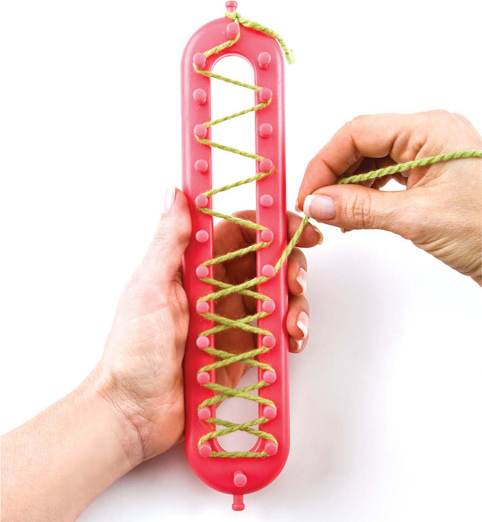
Lay a piece of scrap yarn over the wrapped yarn. Let the tails of the scrap yarn hang between the wrapped yarn and the loom. The scrap yarn tails can be tied together so it stays in place.

Push the wraps down on the pegs so there is space to put another wrap of yarn above them on the pegs. Unless otherwise specified, each yarn wrap goes above the existing wrap on the pegs.
The cast on is complete. The next wrap of the loom is the first row, in the stitch pattern indicated in the project instructions.
Start at the edge of the knitting opposite the beginning tail. Untie the scrap yarn.
Put a slip knot loosely on a crochet hook.
Insert the crochet hook into the first loop on the scrap yarn.
Wrap the working yarn around the crochet hook, and pull it through the two loops on the hook.

There will be one loop left on the crochet hook.
Insert the crochet hook into the next two loops on the scrap yarn—they cross over each other. Wrap the working yarn around the crochet hook and pull it through the three loops on the hook, leaving one loop left on the hook.
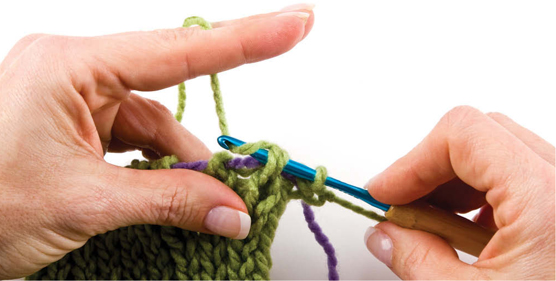
Continue across the width of the knitting.
The last stitch is made with the single loop left on the scrap yarn.
Cut the working yarn, leaving a 6-inch tail. Make one more crochet stitch. Then, wrap the crochet hook with both the working yarn and the beginning tail, pulling them both all the way through the loop on the hook. Pull gently on the working yarn tail to close the loop against the knitting.
Gently pull the scrap yarn free from the knitting.
With the working yarn on the right end of the loom, bring the loops from the far side of the loom to the near side.

The loom will have no loops on one side and two loops on the other side.
Bring the working yarn to the left in front of the first two pegs, and knit them off, bringing the two bottom loops over the top one loop.
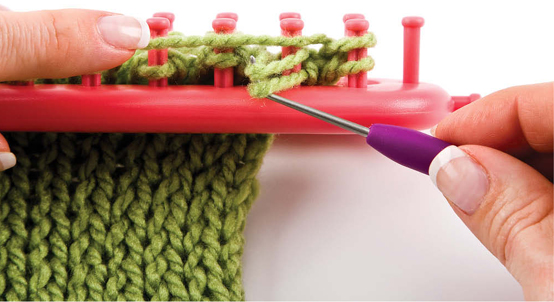
Make sure the new loops are loose.
Take the second loop off the loom and put it on the first peg. Knit off the first peg.

Move the remaining loop to the empty peg on the left.

Knit the next peg as before, and then move it above the loop on the peg to the right. Knit off. Move the remaining loop to the empty peg on the left.
Continue across the width of the knitting.
When there is one loop left on the loom cut the yarn, leaving a 6-inch tail. Wrap the peg and knit off. Wrap the peg again and knit off, pulling the cut yarn end through the loop. Remove the loop from the loom and gently pull the tail to close the loop against the knitting.
With the working yarn on the right end of the loom, bring the loops from the far side of the loom to the near side.
The loom will have no loops on one side and two loops on the other side.

Cut a piece of scrap yarn 2–3 times longer than the width of the knitting and thread it into a blunt tapestry needle.
Starting at one end of the loom, bring the needle through the first loop on the peg, sliding the needle along the groove in the peg from the bottom to the top.
Thread the needle through each peg on the loom in order, sliding the needle along the groove in the peg from the bottom to the top.

When all loops have been threaded, remove the loops from the pegs.
Tie the ends of the scrap yarn together to secure them so the loops remain captured. Leave enough slack in the scrap yarn so the knitting isn’t gathered.
A new strand of yarn can be added at any point in the row, though color changes generally happen on the last stitch of the row.
Cut the old color yarn, leaving a 6-inch tail. Wrap the last peg with the old color and the new color yarn above it. Knit off to secure both yarn ends.

Continue knitting in your stitch pattern with just the new color.
The yarn tails can be laid across the knitting in between the pegs to hide them so they don’t need to be woven in later.
Lay the two pieces of knit fabric side by side. Thread an 18-inch length of yarn in a blunt tapestry needle.
You will be catching the yarn where it crisscrosses between the upper and lower edges of the fabric.
Starting at the bottom edges of the knit pieces, put the needle in the first crisscross on the fabric on the right.
Put the needle in the first two crisscrosses on the fabric on the left.
Catch the next two crisscrosses on the right-hand fabric.
Continue in this manner, catching two crisscrosses on each side.

Every couple inches, hold the beginning yarn tail and pull gently on the yarn near the last stitch. This will straighten the stitches, making them almost straight up and down instead of right and left, and will draw the two knit pieces close together, hiding the seam.
Make a slip knot and put it on the crochet hook.
With wrong sides together, match the edges of the two knit pieces so the edge stitches line up.
Put the crochet hook into the top edge loop of each knit piece.
Wrap the yarn around the crochet hook and pull it through the three loops on the hook, leaving one new loop on the crochet hook.
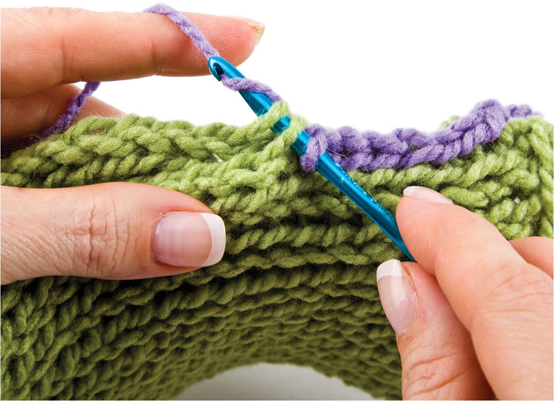
Repeat the last two steps until the end of the seam is reached. With one loop on the crochet hook, wrap the yarn around the hook and pull it through the loop. Wrap and pull through again. Cut the yarn, leaving a 6-inch tail. Pull on the loop until the cut edge comes through. Gently pull on the tail until the loop closes snug against the knitting.
Weave in tails.
The decrease is done using the three peg pairs at the end of the loom.
Move the loops on pegs 2 to pegs 3.

Move the loops on pegs 1 to pegs 2.
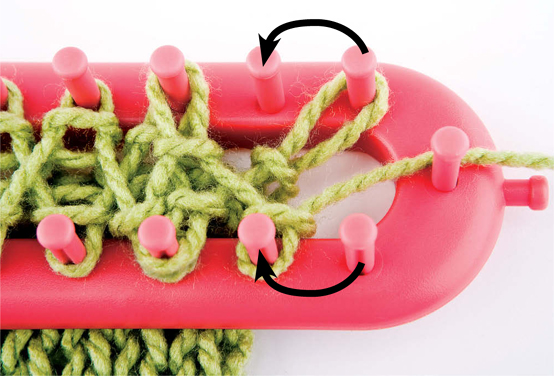
Pegs 1 are empty, there is one loop on each of pegs 2, and there are two loops on each of pegs 3.
When knitting the next row, pegs 3 are knit off as two-over-one.
The increase is done using three peg pairs.
Move the loops on pegs 1 away from the knitting by one peg.
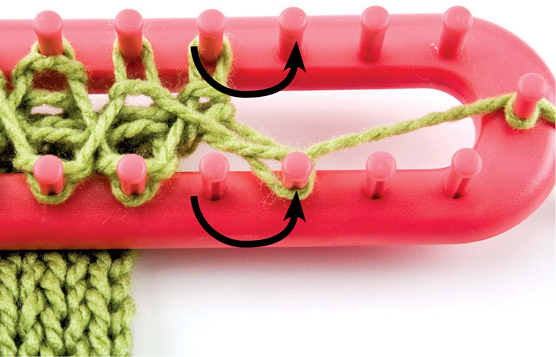
Move the next set of loops to the empty pegs.

Move the just-knit-off loops from the back sides of the pegs on either side of the empty peg to the empty peg.

This prevents a hole in the fabric at the increase point.
Wrap and knit the next row. When knitting the peg containing the just-knit-off loops, bring the bottom two loops over the one top loop.
When there are two loops on the peg, insert the hook tool into the bottom loop. Pull it away from the loom slightly, and then bring it up over the top loop and off the peg. Place the loop behind the peg in the center of the loom.
In some cases, there will be more than two loops on the peg. Follow the pattern instructions for knitting off two-over-one (two bottom loops over one top loop), one-over-two (one bottom loop over two top loops), etc. ![]()

Tips for Success
• When binding off and finishing the cast-on end, make sure your stitches are large enough that the ends can stretch with the knitting instead of constricting it. Check the stretch before cutting the working yarn, in case you need to redo the stitches to make them looser.
• When choosing scrap strands for the cast on and removing the knitting from the loom, select yarn that is smooth, not textured, in a contrasting color, and in a similar or larger thickness than the working yarn. This will make it easier to see and crochet the stitches when finishing the ends.
• After wrapping the loom for a row of stitches, knit off the last peg you wrapped first. This will anchor the yarn so it doesn’t come loose from the loom.